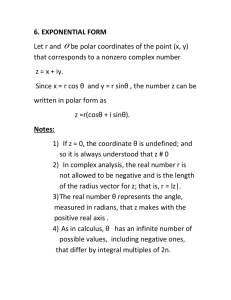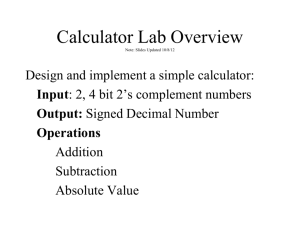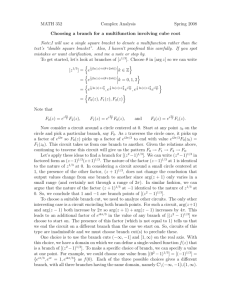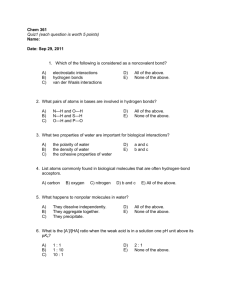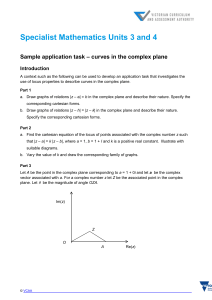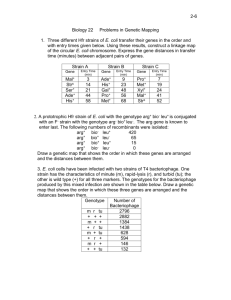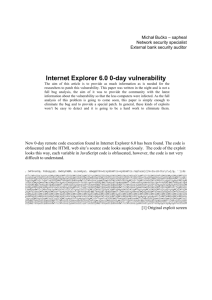The complex logarithm, exponential and power functions
advertisement
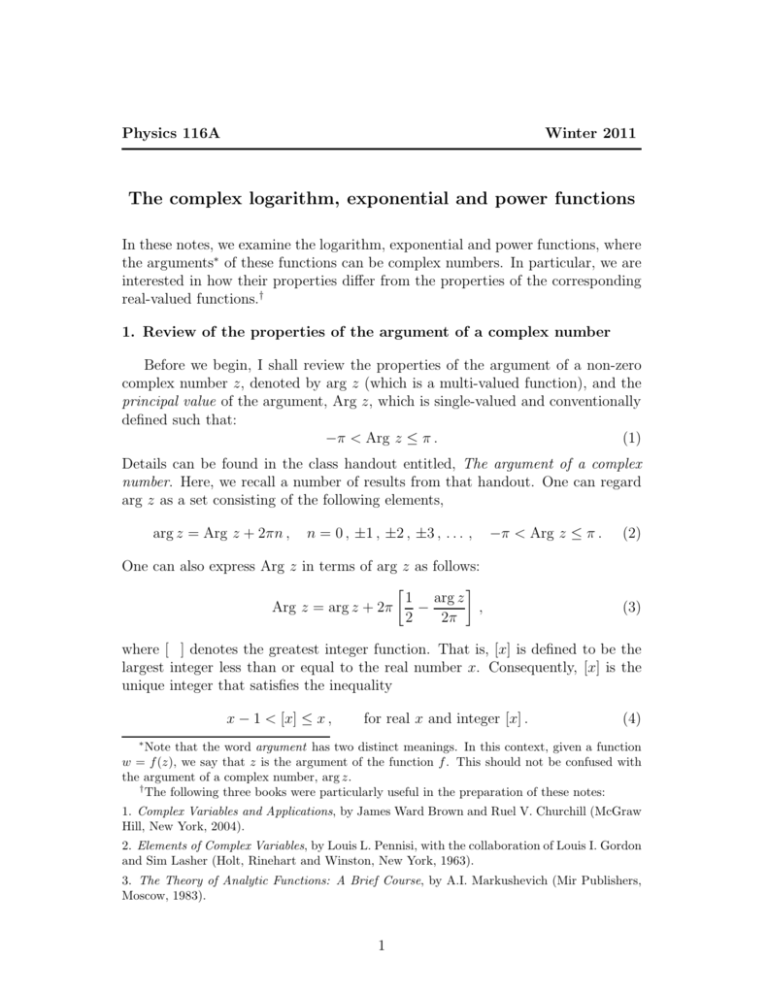
Physics 116A
Winter 2011
The complex logarithm, exponential and power functions
In these notes, we examine the logarithm, exponential and power functions, where
the arguments∗ of these functions can be complex numbers. In particular, we are
interested in how their properties differ from the properties of the corresponding
real-valued functions.†
1. Review of the properties of the argument of a complex number
Before we begin, I shall review the properties of the argument of a non-zero
complex number z, denoted by arg z (which is a multi-valued function), and the
principal value of the argument, Arg z, which is single-valued and conventionally
defined such that:
−π < Arg z ≤ π .
(1)
Details can be found in the class handout entitled, The argument of a complex
number. Here, we recall a number of results from that handout. One can regard
arg z as a set consisting of the following elements,
arg z = Arg z + 2πn ,
n = 0 , ±1 , ±2 , ±3 , . . . ,
−π < Arg z ≤ π .
One can also express Arg z in terms of arg z as follows:
1 arg z
,
−
Arg z = arg z + 2π
2
2π
(2)
(3)
where [ ] denotes the greatest integer function. That is, [x] is defined to be the
largest integer less than or equal to the real number x. Consequently, [x] is the
unique integer that satisfies the inequality
x − 1 < [x] ≤ x ,
for real x and integer [x] .
(4)
∗
Note that the word argument has two distinct meanings. In this context, given a function
w = f (z), we say that z is the argument of the function f . This should not be confused with
the argument of a complex number, arg z.
†
The following three books were particularly useful in the preparation of these notes:
1. Complex Variables and Applications, by James Ward Brown and Ruel V. Churchill (McGraw
Hill, New York, 2004).
2. Elements of Complex Variables, by Louis L. Pennisi, with the collaboration of Louis I. Gordon
and Sim Lasher (Holt, Rinehart and Winston, New York, 1963).
3. The Theory of Analytic Functions: A Brief Course, by A.I. Markushevich (Mir Publishers,
Moscow, 1983).
1
For example, [1.5] = [1] = 1 and [−0.5] = −1. One can check that Arg z as
defined in eq. (3) does fall inside the principal interval specified by eq. (1).
The multi-valued function arg z satisfies the following properties,
arg(z1 z2 ) = arg z1 + arg z2 ,
z1
= arg z1 − arg z2 .
arg
z2
1
= arg z = − arg z .
arg
z
(5)
(6)
(7)
Eqs. (5)–(7) should be viewed as set equalities, i.e. the elements of the sets indicated by the left-hand side and right-hand side of the above identities coincide.
However, the following results are not set equalities:
arg z + arg z 6= 2 arg z ,
arg z − arg z 6= 0 ,
(8)
arg(1) = arg z − arg z 6= 0 .
(9)
which, by virtue of eqs. (5) and (6), yield:
arg z 2 = arg z + arg z 6= 2 arg z ,
For example, arg(1) = 2πn, for n = 0 ± 1, ±2, . . .. More generally,
arg z n = arg z + arg z + · · · arg z 6= n arg z .
{z
}
|
(10)
Arg (z1 z2 ) = Arg z1 + Arg z2 + 2πN+ ,
(11)
Arg (z1 /z2 ) = Arg z1 − Arg z2 + 2πN− ,
(12)
n
We also note some properties of the the principal value of the argument.
where the integers N± are determined as follows:
if Arg z1 ± Arg z2 > π ,
−1 ,
N± =
0,
if −π < Arg z1 ± Arg z2 ≤ π ,
1,
if Arg z1 ± Arg z2 ≤ −π .
If we set z1 = 1 in eq. (12), we find that
(
Arg z ,
Arg(1/z) = Arg z =
−Arg z ,
if Im z = 0 and z 6= 0 ,
if Im z 6= 0 .
(13)
(14)
Note that for z real, both 1/z and z are also real so that in this case z = z and
Arg(1/z) = Arg z = Arg z. In addition, in contrast to eq. (10), we have
Arg(z n ) = n Arg z + 2πNn ,
2
(15)
where the integer Nn is given by:
1
n
Nn =
−
Arg z ,
2 2π
(16)
and [ ] is the greatest integer bracket function introduced in eq. (4).
2. Properties of the real-valued logarithm, exponential and power functions
Consider the logarithm of a positive real number. This function satisfies a
number of properties:
eln x = x ,
(17)
ln(ea ) = a ,
(18)
ln(xy) = ln(x) + ln(y) ,
x
ln
= ln(x) − ln(y) ,
y
1
= − ln(x) ,
ln
x
ln xp = p ln x ,
(19)
(20)
(21)
(22)
for positive real numbers x and y and arbitrary real numbers a and p. Likewise,
the power function defined over the real numbers satisfies:
xa = ea ln x ,
(23)
xa xb = xa+b ,
(24)
xa
= xa−b ,
xb
1
= x−a ,
xa
(xa )b = xab ,
(xy)a = xa y a ,
a
x
= xa y −a ,
y
(25)
(26)
(27)
(28)
(29)
for positive real numbers x and y and arbitrary real numbers a and b. Closely
related to the power function is the generalized exponential function defined over
3
the real numbers. This function satisfies:
ax = ex ln a ,
(30)
ax ay = ax+y ,
(31)
ax
= ax−y ,
ay
1
= a−x ,
ax
(ax )y = axy ,
(32)
(33)
(34)
(ab)x = ax bx ,
(35)
a x
= ax b−x .
(36)
b
for positive real numbers a and b and arbitrary real numbers x and y.
We would like to know which of these relations are satisfied when these functions are extended to the complex plane. It is dangerous to assume that all of
the above relations are valid in the complex plane without modification, as this
assumption can lead to seemingly paradoxical conclusions. Here are three examples:
1. Since 1/(−1) = (−1)/1 = −1,
r
r
1
−1
1
i
= =
= .
−1
i
1
1
Hence, 1/i = i or i2 = 1. But i2 = −1, so we have proven that 1 = −1.
2. Since 1 = (−1)(−1),
p
√
√
√
1 = 1 = (−1)(−1) = ( −1)( −1) = i · i = −1 .
3. To prove that ln(−z) = ln(z) for all z 6= 0, we proceed as follows:
ln(z 2 ) = ln[(−z)2 ] ,
ln(z) + ln(z) = ln(−z) + ln(−z) ,
2 ln(z) = 2 ln(−z) ,
ln(z) = ln(−z) .
Of course, all these “proofs” are faulty. The fallacy in the first two proofs can
be traced back to eqs. (28) and (29), which are true for real-valued functions but
not true in general for complex-valued functions. The fallacy in the third proof
is more subtle, and will be addressed later in these notes. A careful study of the
complex logarithm, power and exponential functions will reveal how to correctly
modify eqs. (17)–(36) and avoid pitfalls that can lead to false results.
4
3. Definition of the complex exponential function
We begin with the complex exponential function, which is defined via its power
series:
∞
X
zn
ez =
,
n!
n=0
where z is any complex number. Using this power series definition, one can verify
that:
ez1 +z2 = ez1 ez2 ,
for all complex z1 and z2 .
(37)
In particular, if z = x + iy where x and y are real, then it follows that
ez = ex+iy = ex eiy = ex (cos y + i sin y) .
One can quickly verify that eqs. (30)–(33) are satisfied by the complex exponential
function. In addition, eq. (34) clearly holds when the outer exponent is an integer:
(ez )n = enz ,
n = 0 , ±1 , ±2 , . . . .
(38)
If the outer exponent is a non-integer, then the resulting expression is a multivalued power function. We will discuss this case in more detail in section 8.
Before moving on, we record one key property of the complex exponential:
e2πin = 1 ,
n = 0 , ±1 , ±2 , ±3 , . . . .
(39)
4. Definition of the complex logarithm
In order to define the complex logarithm, one must solve the complex equation:
z = ew ,
(40)
for w, where z is any non-zero complex number. If we write w = u + iv, then
eq. (40) can be written as
eu eiv = |z|ei arg z .
(41)
Eq. (41) implies that:
|z| = eu ,
v = arg z .
The equation |z| = eu is a real equation, so we can write u = ln |z|, where ln |z| is
the ordinary logarithm evaluated with positive real number arguments. Thus,
w = u + iv = ln |z| + i arg z = ln |z| + i(Arg z + 2πn) , n = 0 , ±1 , ±2 , ±3 , . . .
(42)
5
We call w the complex logarithm and write w = ln z. This is a somewhat awkward
notation since in eq. (42) we have already used the symbol ln for the real logarithm.
We shall finesse this notational quandary by denoting the real logarithm in eq. (42)
by the symbol Ln. That is, Ln|z| shall denote the ordinary real logarithm of |z|.
With this notational convention, we rewrite eq. (42) as:
ln z = Ln|z| + i arg z = Ln|z| + i(Arg z + 2πn) , n = 0 , ±1 , ±2 , ±3 , . . . (43)
for any non-zero complex number z.
Clearly, ln z is a multi-valued function (as its value depends on the integer n).
It is useful to define a single-valued function complex function, Ln z, called the
principal value of ln z as follows:
Ln z = Ln |z| + iArg z ,
−π < Arg z ≤ π ,
(44)
which extends the definition of Ln z to the entire complex plane (excluding the
origin, z = 0, where the logarithmic function is singular). In particular, eq. (44)
implies that Ln(−1) = iπ. Note that for real positive z, we have Arg z = 0, so
that eq. (44) simply reduces to the usual real logarithmic function in this limit.
The relation between ln z and its principal value is simple:
ln z = Ln z + 2πin ,
n = 0 , ±1 , ±2 , ±3 , . . . .
5. Properties of the complex logarithm
We now consider which of the properties given in eqs. (17)–(22) apply to the
complex logarithm. Since we have defined the multi-value function ln z and the
single-valued function Ln z, we should examine the properties of both these functions. We begin with the multi-valued function ln z. First, we examine eq. (17).
Using eq. (43), it follows that:
eln z = eLn|z| eiArg z e2πin = |z|eiArg
z
=z.
(45)
Thus, eq. (17) is satisfied. Next, we examine eq. (18) for z = x + iy:
ln(ez ) = Ln|ez | + i(arg ez ) = Ln(ex ) + i(y + 2πk) = x + iy + 2πik = z + 2πik ,
where k is an arbitrary integer. In deriving this result, we used the fact that
ez = ex eiy , which implies that arg(ez ) = y + 2πk.‡ Thus,
ln(ez ) = z + 2πik 6= z ,
‡
unless k = 0 .
(46)
Note that Arg ez = y + 2πN , where N is chosen such that −π < y + 2πN ≤ π. Moreover,
eq. (2) implies that arg ez = Arg ez + 2πn, where n = 0, ±1, ±2, . . .. Hence, arg(ez ) = y + 2πk,
where k = n + N is still some integer.
6
This is not surprising, since ln(ez ) is a multi-valued function, which cannot be
equal to the single-valued function z. Indeed eq. (18) is false for the multi-valued
complex logarithm.
As a check, let us compute ln(eln z ) in two different ways. First, using eq. (45),
it follows that ln(eln z ) = ln z. Second, using eq. (46), ln(eln z ) = ln z + 2πik. This
seems to imply that ln z = ln z + 2πik. In fact, the latter is completely valid as a
set equality in light of eq. (43).
We now consider the properties exhibited in eqs. (19)–(22). Using the definition of the multi-valued complex logarithms and the properties of arg z given in
eqs. (5)–(7), it follows that eqs. (19)–(21) are satisfied as set equalities:
ln(z1 z2 ) = ln z1 + ln z2 ,
z1
ln
= ln z1 − ln z2 .
z2
1
= − ln z .
ln
z
(47)
(48)
(49)
However, one must be careful in employing these results. One should not make
?
?
the mistake of writing, for example, ln z + ln z = 2 ln z or ln z − ln z = 0. Both
these latter statements are false for the same reasons that eqs. (8) and (9) are not
identities under set equality. In particular, the multi-valued complex logarithm
does not satisfy eq. (22) when p is an integer n:
ln z n = |ln z + ln z {z
+ · · · + ln z} 6= n ln z ,
(50)
n
which follows from eq. (10). If p is not an integer, then z p is a complex multivalued function, and one needs further analysis to determine whether eq. (22) is
valid. In section 6, we will prove [see eq. (60)] that eq. (22) is satisfied by the
complex logarithm only if p = 1/n where n is an integer. In this case,
1
ln(z 1/n ) = ln z ,
n = 1, 2, 3, ... .
(51)
n
We next examine the properties of the single-valued function Ln z. Again,
we examine the six properties given by eqs. (17)–(22). First, eq. (17) is trivially
satisfied since
eLn z = eLn|z| eiArg
z
= |z|eiArg
z
= z.
(52)
However, eq. (18) is generally false. In particular, for z = x + iy
Ln(ez ) = Ln |ez | + i(Arg ez ) = Ln(ex ) + i(Arg eiy ) = x + iArg (eiy )
1 arg(eiy )
1
y
iy
= x + i arg(e ) + 2πi
= x + iy + 2πi
−
−
2
2π
2 2π
1 Im z
= z + 2πi
,
(53)
−
2
2π
7
after using eq. (3), where [ ] is the greatest integer bracket function defined in
eq. (4). Thus, eq. (18) is satisfied only when −π < y ≤ π. For values of y outside
the principal interval, eq. (18) contains an additive correction term as shown in
eq. (53).
As a check, let us compute Ln(eLnz ) in two different ways. First, using eq. (52),
it follows that Ln(eLn z ) = Ln z. Second, using eq. (53),
1 Arg z
1 Im Ln z
Ln z
= Ln z + 2πi
= Ln z ,
−
−
Ln(e
) = Lnz + 2πi
2
2π
2
2π
where we have used Im Ln z = Arg z [see eq. (44)]. In the last step, we noted
that
1 Arg(z)
0≤ −
< 1,
2
2π
due to eq. (1), which implies that the integer part of 21 − Arg z/(2π) is zero. Thus,
the two computations agree.
We now consider the properties exhibited in eqs. (19)–(22). Ln z may not
satisfy any of these properties due to the fact that the principal value of the
complex logarithm must lie in the interval −π < Im Ln z ≤ π. Using the results
of eqs. (11)–(16), it follows that
Ln (z1 z2 ) = Ln z1 + Ln z2 + 2πiN+ ,
(54)
Ln (z1 /z2 ) = Ln z1 − Ln z2 + 2πiN− ,
(55)
Ln(z n ) = n Ln z + 2πiNn
(integer n) ,
(56)
where the integers N± = −1, 0 or +1 and Nn are determined by eqs. (13) and
(16), respectively, and
(
−Ln(z) + 2πi ,
if z is real and negative ,
(57)
Ln(1/z) =
−Ln(z) ,
otherwise .
Note that eq. (19) is satisfied if Re z1 > 0 and Re z2 > 0 (in which case N+ = 0).
In other cases, N+ 6= 0 and eq. (19) fails. Similar considerations also apply to
eqs. (20)–(22). For example, eq. (21) is satisfied by Ln z unless Arg z = π
(equivalently for negative real values of z), as indicated by eq. (57). In particular,
one may use eq. (56) to verify that:
Ln[(−1)−1 ] = −Ln(−1) + 2πi = −πi + 2πi = πi = Ln(−1) ,
as expected, since (−1)−1 = −1.
We cannot yet check whether eq. (22) is satisfied if p is a non-integer, since in
this case z p is a multi-valued function. Thus, we now turn our attention to the
complex power functions (and the related generalized exponential functions).
8
6. Definition of the generalized power and exponential functions
The generalized complex power function is defined via the following equation:
w = z c = ec ln z ,
z 6= 0 .
(58)
To motivate this definition, we first note that if c = k is an integer, then for
z = |z|ei arg z ,
z k = |z|k eki arg z = ek Ln|z| eki arg z = ek(Ln|z|+i arg z) = ek ln z .
In this case, w = z k is a single-valued function, since
z k = ek ln z = ek(Ln z + 2πin) = ek Ln z .
If c = 1/k (where k is an integer), then we have:
z 1/k = |z|1/k ei arg(z)/k = eLn|z|/k ei arg(z)/k = e(Ln|z|+i arg z)/k = eln(z)/k ,
where |z|1/k refers to the positive real kth root of |z|. Combining the two results
just obtained, we can easily prove that eq. (58) holds for any rational real number
c. Since any irrational real number can be approximated (to any desired accuracy)
by a rational number, it follows by continuity that eq. (58) must hold for any real
number c. These arguments provide the motivation for defining the generalized
complex power function as in eq. (58) for an arbitrary complex power c.
Note that due to the multi-valued nature of ln z, it follows that w = z c = ec ln z
is also multi-valued for any non-integer value of c, with a branch point at z = 0:
w = z c = ec ln z = ec Ln z e2πinc ,
n = 0 , ±1 , ±2 , ±3 , · · · .
(59)
If c is a rational number of the form c = m/k, where m and k are integers with
no common divisor, then we may take n = 0, 1, 2, . . . , k − 1 in eq. (59), since
other values of n will not produce any new values of z m/k . It follows that the
multi-valued function w = z m/k has precisely k distinct branches. If c is irrational
or complex, then the number of branches is infinite (with one branch for each
possible choice of integer n).
Having defined the multi-valued complex power function, we are now able to
compute ln(z c ):
ln(z c ) = ln(ec ln z ) = ln(ec (Ln z+2πim) ) = ln(ec Ln z e2πimc )
= ln(ec Ln z ) + ln(e2πimc ) = c (Ln z + 2πim) + 2πik
2πik
,
= c ln z + 2πik = c ln z +
c
(60)
where k and m are arbitrary integers. Thus, ln(z c ) = c ln z in the sense of set
equality (in which case the sets corresponding to ln z and ln z + 2πik/c coincide)
9
if and only if k/c is an integer for all values of k. The only possible way to satisfy
this latter requirement is to take c = 1/n, where n is an integer. Thus, eq. (51) is
now verified.
We can define a single-valued power function by selecting the principal value
of ln z in eq. (58). Consequently, the principal value of z c is defined by
Z c = ec Ln z ,
z 6= 0 .
For a lack of a better notation, I will indicate the principal value by capitalizing
the variable Z as above. The principal value definition of z c can lead to some
unexpected results. For example, consider the principal value of the cube root
function w = Z 1/3 = eLn(z)/3 . Then, for z = −1, the principal value of
√ √
3
−1 = eLn(−1)/3 = eπi/3 = 12 1 + i 3 .
√
This may have surprised you, if you were expecting that 3 −1 = −1. To obtain
the latter result would require a different choice of the principal interval in the
definition of the principal value of z 1/3 .
We are now in the position to check eq. (22) in the case that both the complex
logarithm and complex power function are defined by their principal values. That
is, we compute:
Ln(Z c ) = Ln(ec Ln z ) = c Ln z + 2πiNc ,
after using eq. (53), where Nc is an integer determined by
1 Im (c Ln z)
,
−
Nc ≡
2
2π
(61)
(62)
and [ ] is the greatest integer bracket function defined in eq. (4). Nc can be
evaluated by noting that:
Im (c Ln z) = Im {c (Ln|z| + iArg z)} = Arg z Re c + Ln|z| Im c .
Note that if c = n where n is an integer, then eq. (61) simply reduces to eq. (56),
as expected. We conclude that eq. (22) is generally false both for the multi-valued
complex logarithm and its principal value.
A function that in some respects is similar to the complex power function
is the generalized exponential function. A possible definition of the generalized
exponential function for c 6= 0 is:
w = cz = ez ln c = ez(Ln c+2πin) ,
n = 0 , ±1 , ±2 , ±3 , · · · .
(63)
However, the multi-valued nature of this function differs somewhat from the multivalued power function. In contrast to the latter, the generalized exponential
function possesses no branch point (or any other type of singularity) in the finite
10
complex z-plane. Thus, one can regard eq. (63) as defining a set of independent
single-valued functions for each value of n. Typically, the n = 0 case is the most
useful, in which case, we would simply define:
w = cz = ez Ln c ,
c 6= 0 .
(64)
This conforms with our definition of the exponential function in section 3 (where
c = e). Henceforth, we shall employ eq. (64) as the definition of the single-valued
generalized exponential function.§
Some results for the principal value of the complex power function can be
immediately adapted to the generalized exponential function. For example, by an
almost identical computation as in eqs. (61) and (62), we find that:
Ln(cz ) = Ln(ez Ln c ) = z Ln c + 2πiNc′ ,
where Nc′ is an integer determined by:
1 Im (z Ln c)
′
.
−
Nc ≡
2
2π
(65)
(66)
7. Properties of the generalized power function
Let us examine the properties listed in eqs. (23)–(29). Eq. (23) defines the
complex power function. It is tempting to write:
?
z a z b = ea ln z eb ln z = ea ln z+b ln z = e(a+b) ln z = z a+b .
(67)
However, consider the case of non-integer a and b where a + b is an integer. In
this case, eq. (67) cannot be correct since it would equate a multi-valued function
z a z b with a single-valued function z a+b . In fact, the questionable step in eq. (67)
is false:
?
a ln z + b ln z = (a + b) ln z
[FALSE!!].
(68)
We previously noted that eq. (68) is false in the case of a = b = 1 [cf. eq. (8)]. A
more careful computation yields:
z a z b = ea ln z eb ln z = ea(Ln z+2πin) eb(Ln z+2πik) = e(a+b)Ln z e2πi(na+kb) ,
z a+b = e(a+b) ln z = e(a+b)(Ln z+2πik) = e(a+b)Ln z e2πik(a+b) ,
(69)
where k and n are arbitrary integers. Hence, z a+b is a subset of z a z b . Whether
the set of values for z a z b and z a+b does or does not coincide depends on a and b.
However, in general, eq. (24) does not hold.
§
In practice, many textbooks treat the generalized exponential function as a single-valued
function, cz = ez Ln c , only when c is a positive real number. For any other value of c, the
multi-valued function cz = ez ln c is preferred. We shall not pursue this approach in these notes.
11
Similarly,
ea ln z
ea(Ln z+2πin)
za
=
=
= e(a−b)Ln z e2πi(na−kb) ,
zb
eb ln z
eb(Ln z+2πik)
z a−b = e(a−b) ln z = e(a−b)(Ln z+2πik) = e(a−b)Ln z e2πik(a−b) ,
(70)
where k and n are arbitrary integers. Hence, z a−b is a subset of z a /z b . Whether
the set of values z a /z b and z a−b does or does not coincide depends on a and b.
However, in general, eq. (25) does not hold. Setting a = b in eq. (70) yields the
expected result:
z0 = 1 ,
z 6= 0
for any non-zero complex number z. Setting a = 0 in eq. (70) yields the set
equality:
z −b =
1
,
zb
(71)
i.e., the set of values for z −b and 1/z b coincide. Thus, eq. (26) is satisfied. Note,
however, that
z a z −a = ea ln z e−a ln z = ea(ln z−ln z) = ea ln 1 = e2πika ,
where k is an arbitrary integer. Hence, if a is a non-integer, then z a z −a 6= 1 for
k 6= 0. This is not in conflict with the set equality given in eq. (71) since there
always exists at least one value of k (namely k = 0) for which z a z −a = 1.
To show that eq. (27) can fail, we use eq. (46) in concluding that
(z a )b = (ea ln z )b = eb ln(e
a ln z )
= eb(a ln z+2πik) = eba ln z e2πibk = z ab e2πibk ,
where k is an arbitrary integer. Thus, z ab is a subset of (z a )b . The elements of z ab
and (z a )b coincide if and only if b is an integer. For example, if z = a = b = i, we
find that:
(ii )i = ii·i e−2πk = i−1 e−2πk = −ie−2πk ,
k = 0 , ±1 , ±2 , · · · .
(72)
On the other hand, eqs. (28) and (29) are satisfied by the multi-valued power
function, since
(z1 z2 )a = ea ln(z1 z2 ) = ea(ln z1 +ln z2 ) = ea ln z1 ea ln z2 = z1a z2a ,
a
z1
= ea ln(z1 /z2 ) = ea(ln z1 −ln z2 ) = ea ln z1 e−a ln z2 = z1a z2−a .
z2
We now repeat the above analysis for the principal value of the power function,
Z c = ec Ln z . In this case, the results are somewhat reversed from the case of the
12
multi-valued power function. In particular, eqs. (24)–(26) are satisfied, whereas
eqs. (27)–(29) may be violated. For example, for the single-valued power function,
Z a Z b = eaLn z ebLn z = e(a+b)Ln z = Z a+b ,
(73)
eaLn z
Za
=
= e(a−b)Ln z = Z a−b ,
Zb
ebLn z
(74)
Z a Z −a = eaLn z e−aLn z = 1 .
(75)
Setting a = b in eq. (74) yields Z 0 = 1 (for z 6= 0) as expected.
Eq. (27) may be violated since eq. (53) implies that
(Z c )b = (ecLn z )b = eb Ln(e
cLn z )
= eb(cLn z+2πiNc ) = ebc Ln z e2πibNc = Z cb e2πibNc ,
where Nc is an integer determined by eq. (62). As an example, if z = b = c = i,
eq. (62) gives Nc = 0, which yields the principal value of (ii )i = ii·i = i−1 = −i.
However, in general Nc 6= 0 is possible in which case eq. (27) does not hold.
Eqs. (28) and (29) may also be violated since eqs. (54) and (55) imply that
(Z1 Z2 )a = eaLn(z1 z2 ) = ea(Ln z1 +Ln z2 +2πiN+ ) = Z1a Z2a e2πiaN+ ,
a
Za
Z1
= eaLn(z1 /z2 ) = ea(Ln z1 −Ln z2 +2πiN− ) = 1a e2πiaN− ,
Z2
Z2
(76)
(77)
where the integers N± are determined from eq. (13).
8. Properties of the generalized exponential function
The generalized exponential function, w = cz (c 6= 0), is a single-valued function defined by eq. (64). Using this definition and the properties of the complex
exponential function ez , one can quickly check whether eqs. (31)–(36) hold in the
complex plane. The proof of eqs. (31)–(33) is nearly identical to the one given in
eqs. (73)–(75):
cz1 cz2 = ez1 Ln c ez2 Ln c = e(z1 +z2 )Ln c = cz1 +z2 ,
(78)
cz 1
ez1 Ln c
=
= e(z1 −z2 )Ln c = cz1 −z2 ,
cz 2
ez2 Ln c
(79)
cz c−z = ezLn c e−zLn c = 1 .
(80)
However, eq. (34) does not generally hold. Using eq. (65),
(cz1 )z2 = ez2 Ln(c
z1 )
′
′
′
= ez2 (z1 Ln c+2πiNc ) = ez2 z1 Ln c e2πiz2 Nc = cz1 z2 e2πiz2 Nc , (81)
where Nc′ is determined by eq. (66) [with z replaced by z1 ].
13
The case of c = e is noteworthy. Eq. (81) reduces to:
1 Im z1
z1 z2
z1 z2 2πiz2 Ne′
′
.
−
(e ) = e e
,
Ne ≡
2
2π
(82)
′
If z2 = n where n is any integer, then e2πinNe = 1 (since Ne′ is an integer by
definition of the bracket notation). Thus, we recover eq. (38).
Let us test eq. (82) by substituting z1 = −iπ. Then, Ne′ = 1 and hence
(e−πi )z = eiπz .
This result may seem strange, but it is a consequence of our definition of the
generalized exponential function, cz = ez Ln c , which employs the principal value
of the logarithm. Indeed
(e−iπ )z = (−1)z = ez Ln(−1) = eiπz ,
since Ln(−1) = iπ. We conclude that eq. (34) can be violated, even for the
ordinary exponential function.
Ultimately, the real difficulty with (cz1 )z2 is that it is simultaneously a generalized exponential function and a generalized power function. Thus, if z2 is a
non-integer, it may be more convenient to treat (cz1 )z2 as a multi-valued function.
That is, in this latter convention, we treat the generalized exponential function
cz1 = ez1 Ln c as a single-valued function (using the principal value definition of
the logarithm in the exponent), whereas we treat the generalized power function
z
(cz1 )z2 = ez2 ln(c 1 ) as a possible multi-valued function:
(cz1 )z2 = ez2 ln(c
z1 )
= ez2 ln(e
z1 Ln c )
= ez2 (z1 Ln c+2πik) = ez2 z1 Ln c e2πiz2 k = cz1 z2 e2πikz2 ,
where k is an arbitrary integer [see eq. (46)]. In particular, for z2 a non-integer,
(cz1 )z2 is a multi-valued function, with branches corresponding to different choices
of k. For example, for c = z1 = z2 = i, we recover eq. (72). One might be
tempted to call the k = 0 branch the principal value of (cz1 )z2 , in which case
eq. (34) would be valid. Clearly, we must define our conventions carefully if we
wish to manipulate expressions involving exponentials of exponentials.
Finally, eqs. (35) and (36) may be violated. The calculation is nearly identical
to the one given in eqs. (76) and (77):
(ab)z = ezLn(ab) = ez(Ln a+Ln b+2πiN+ ) = az bz e2πizN+ ,
a z
az
= ezLn(a/b) = ez(Ln a−Ln b+2πiN− ) = z e2πizN− ,
b
b
where the integers N± are determined from eq. (13) [with z1 and z2 replaced by
a and b, respectively]. If Re a > 0 and Re b > 0, then N± = 0, and eqs. (35) and
(36) are satisfied.
14
